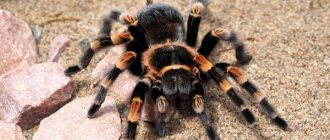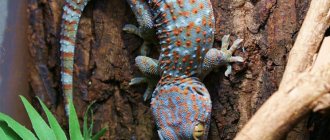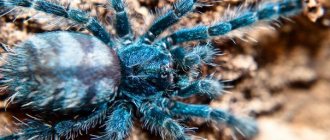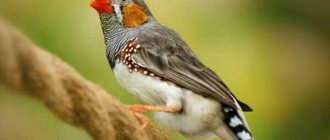- Wild animals
- >>
- Arachnids
The tarantula spider , or tarantula, has a rather memorable and very colorful appearance.
This insect is quite large in size, has long, hairy limbs and a bright color, which becomes even brighter with each subsequent molt. This type of spider is divided into many subspecies. However, they are all considered poisonous to one degree or another. For an adult, healthy person, their bite is unlikely to be fatal, but can provoke chills, nausea, vomiting, convulsions, high fever, a severe allergic reaction, and burns. For an elderly, weakened person, or a child, or a small animal, a bite from this insect can be fatal.
Rules for keeping tarantula spiders at home
As mentioned above, spiders are found in regions with hot climates. This must be taken into account when keeping individuals at home. Among the most important points to pay attention to when placing an animal are the following:
- The pet must move freely around its home, so it needs to choose a spacious container.
- Tarantula spiders love warmth, but bright sunlight harms them. Place your pet in a warm and dark place in the house, and do not forget about the humidity of the room.
- It is necessary to monitor the behavior of individuals; outbreaks of aggression between young and adult pets often occur. Throughout life, there are several key moments, which include periods of reproduction and the emergence of the younger generation. To avoid cannibalism, adult pets should be transplanted from young animals in a timely manner.
- The animal often sheds and pollutes its home; it is necessary to periodically clean the terrarium, as well as change the soil to maintain optimal living conditions.
What should a spider's home be like?
Animals may experience stress when moving from their natural habitat, so choosing a new home is key when it comes to pet placement. When choosing a habitat, pay attention to the following parameters:
- A terrarium or aquarium is perfect for creating an artificial habitat, and there should be enough space for your pet. It is necessary to take into account the size of the individual and take a terrarium with a wall that is twice the length of the animal’s body.
- For underground species, soil at the bottom of the container is suitable; its thickness should be at least 5 cm, and soft and hard layers of soil can be combined. For those individuals that lead a terrestrial lifestyle, you will have to additionally install a snag or a small log in the aquarium. Spiders will crawl along this snag and also weave webs on it.
- An equally important issue is maintaining climatic conditions. The pet's habitat should be warm, the temperature should not be lower than 25 °C. But at the same time, it is better to hide the aquarium from direct exposure to sunlight.
Nutrition
The tarantula spider at home feeds on beetles, cockroaches, earthworms and beetle larvae. Feeding insects are specially grown to feed arthropods. Young animals are given zofobas or darkling beetle larvae; They are popularly called mealworms.
The length of the larva should correspond to 1/3 of the size of the abdomen. If after feeding it does not increase in size, then the individuals are given more food. A sign that the tarantula has eaten is an enlarged abdomen. After molting, adult spiders are given the same soft food as young ones.
At home, the tarantula is fed with darkling beetle, zofobas, Madagascar, Argentine, and Turkmen cockroaches. He can catch a cricket, a grasshopper, a locust, a small lizard. Animals love to hunt them. Insects are placed in a terrarium alive. The remaining feed is removed so that it does not rot.
Care for tarantula spiders is minimal. It is important for them to provide warmth, moist air and soil, and good ventilation. Feeding is carried out once a week. The young are given food every 3 days.
It is recommended to clean the bedding from feces and food residues. To do this, the tarantula is moved to another container. The soil is heated in a frying pan. You must handle the animal with great care.
Cleaning and cleaning, hygiene
Correct and high-quality soil poured into the terrarium is very important . Good soil helps maintain optimal moisture levels. You can choose the soil yourself quite easily. Such a substrate must have good air permeability. Among other things, the soil must be as clean as possible to prevent the development of putrefactive microflora and mold. The optimal substrate is one with sufficient moisture content, but not too fine.
To make the substrate sufficiently moist, it is necessary to regularly wet the soil with clean water at room temperature. Excessive waterlogging and insufficient soil moisture inside the terrarium are unacceptable, and often become the main cause of death or death of a pet. Hygienic cleaning of the walls and bottom of the terrarium should be carried out as it gets dirty. It is also possible to partially replace the substrate.
This is interesting! Experienced owners of tarantula spiders recommend adding coconut substrate to the bottom of the terrarium, which has all the characteristics necessary for keeping arthropods at home.
Reproduction
The sex of a tarantula spider is easy to determine if you follow the recommendations of experts. Young spiders begin to molt after about a month. After molting, the skin is taken and carefully examined. In the posterior region of females there is a depression, and in males there are something like two tubercles. If the individuals are adults, then the sex can be determined by appearance. Males have slightly slimmer legs and are taller, while the body is significantly smaller in size than the female.
After mating, the eggs develop inside the female for 2 months. During this period, she must form a special cocoon. At one time, she can lay up to 500 eggs, while about 50 spiders remain alive. In order for the juveniles to actively develop, the cocoon is moved to a separate terrarium, thereby creating certain temperature conditions.
For the first month, baby spiders do not eat anything, until the first molt. Until this moment, they can be together, after which they are separated one by one. A female tarantula spider molts up to 12 times during her entire life. Males stop moulting immediately after puberty.
Interesting to know ! The tarantula spider is constantly growing and maturing, which is why it needs to shed its “old clothes”. Before molting, individuals turn over on their backs, trying to remove their old skin. At the same time, he completely stops eating. After molting, the spider gets a new color, and the pile is completely renewed.
Interesting Facts
The tarantula spider is a popular animal that attracts people with its large size and original appearance. There is a lot of interesting information about these amazing creatures:
- Spiders do not experience a sense of affection, so when kept at home, you should not think that the animal is attached to its owner and loves him.
- It is impossible to train a tarantula and also be completely sure of the absence of aggression on its part.
- Even the most calm and balanced individuals bite their own owners from time to time.
- Females are larger in size than males.
- Many females devour males after mating.
- Females live longer, up to 30 years, so they are more expensive.
- Females lay approximately 2,000 eggs, which are placed in a cocoon of spider webs and hatch after 1 to 3 months.
- The terrarium with the spider should always be closed with a tight lid. If there are children at home, it is necessary to use a lock, this will protect the child from an accident.
- Spiders are representatives of a separate class, so it is not entirely correct to classify them as insects.
- Tarantulas are the largest spiders in the world.
- Animals use an original method of protection from enemies - blinding by a stream of feces.
- Arthropods are capable of not eating food for more than 2 years.
- Some species are excellent swimmers and divers;
- To treat the fear of spiders (arachnophobia), experts recommend that patients keep tarantulas in their homes to overcome the disease on their own. According to statistics, the technique brings positive results.
Before purchasing a bird catcher, you need to think about the burden of responsibility that will lie on the owner of such a pet. The animal is a long-livers and needs care and proper care.
Tarantula spider
Advantages and disadvantages of keeping a spider
Many people keep spiders for the purpose of shocking. Like, look at the scarecrow that lives with me, is it impressive? But such people are in the minority. There are, of course, individuals who are obsessed with spiders, who admire their habits and opportunistic features. But, basically, spiders are owned by those who consider them to be very beautiful pets.
And from this judgment follows the main, in my opinion, advantage of spiders - their appearance. Now you can buy spiders of a wide variety of colors, there are pink, red, pitch black and even bright blue. These are incredibly beautiful animals that are a pleasure to look at.
This type of spider has very interesting, curled hairs.
The main reason why I got myself a spider is its unpretentiousness. Such a pet can be left for a week or more with a clear conscience. If you need to go somewhere, then rest assured that the spider will wait for you and will not die of hunger, since it can go without food for a very long time.
This is an ideal option if you have a small living space. It does not take up much space and does not create noise. If you remove leftover food, there will be no unpleasant smell either. He doesn't shed his fur in the usual sense and you don't need to walk with him - a miracle, not a pet.
One of the main disadvantages is that spiders are quite secretive people. Most likely, your pet will hide in a shelter most of the time.
You can't pet a spider in the usual sense of the word. Even picking him up is not recommended, as this is very stressful for the animal.
A particular disadvantage is the presence of food animals in your home. For example, if you decide to keep a colony of cockroaches yourself, then you won’t leave them for a month.
Well, despite their terrifying appearance, spiders are quite fragile. Even a fall from several tens of centimeters threatens the spider with death. The animals are quite nervous. Factors such as transportation, changing the terrarium, and an abundance of insects can cause stress. Spider stress is bad. The pet may comb its hairs, refuse to feed and, in especially severe cases, even die.
It doesn’t bark, doesn’t bite, doesn’t rush at passers-by... Just kidding, of course, a spider can bite, it has everything for that. But such cases are extremely rare. Of course, the venom of all tarantulas is toxic to one degree or another. But an adult should not have any serious problems.
Kinds
This family has many representatives, including thirteen subfamilies, divided into a huge number of species (according to official data, there are about 143 of them). The characteristics of their representatives are very characteristic, so the most interesting varieties deserve special description.
1. The Goliath tarantula is a creature famous for its size, which, including the length of its legs, is about 28 cm. Previously, such a specimen of the planet’s fauna was considered the largest of the spiders.
But the very beginning of the 21st century was marked by the discovery of Heteropoda maxima, a relative in the order that lives in the tropics and is a couple of centimeters larger than the Goliath, which means its size is not limiting.
The color of such a spider is brown, sometimes with shades of red or light colors. Such creatures live in the swamps of South America. The weight of males of the species can reach up to 170 g.
Goliath is considered the largest tarantula spider
2. Black and white Brazilian tarantula spider . Representatives of this variety are slightly smaller than the previous one. Their sizes usually do not exceed 23 cm. They are famous for their intensive growth and bright, elegant, although black and white coloring.
The spider has an unpredictable and aggressive character. Often such creatures hide among stones and under tree roots, but sometimes they crawl out into open areas.
3. Metallic tarantula (arboreal) is also a remarkable species that is found only exclusively in southern India. But in this case, the spider stands out from its relatives not at all in its size, growing no more than 21 cm, but in its brightness and bewitching, fabulous beauty.
Its body and paws are blue with a metallic tint, decorated with wonderful patterns. Such creatures, uniting in groups, live among rotten old trees.
4. Smith's brachypelma is a species found in the southern United States and Mexico. The size of such spiders usually does not exceed 17 cm. The color can be black or dark brown with the addition of red and orange areas, in some cases decorated with a yellow or white border; The frequent hairs on the body are light pink.
This species does not have a toxic poison and is not considered particularly aggressive.
In the photo is the Brachypelma Smith spider
As for the size of the tarantula , this has already been mentioned. But the parameters were given earlier taking into account the leg span. However, the body itself of the largest spiders is about 10 cm in size, and in small species it can be less than 3 cm. It should also be mentioned that tarantulas change their color with age and as they mature.
Shedding
Regular replacement of the exoskeleton, which is not capable of stretching, is necessary for the growth of the tarantula and is considered a natural physiological process. The shedding period is called molting. In adults, this happens annually, and at a young age, spiders molt several times a month. The approach of molting is indicated by darkening of the color and partial loss of hairs. Often animals refuse food and lie down on their backs. It happens that when the old integument is shed, the hind legs come off, which later grow back. Important! Tarantulas do not require human assistance when getting rid of their exoskeleton and can even cause harm.
Diseases, treatment and prevention
Diseases affecting tarantulas are currently classified as insufficiently studied, so there is no established practice for their treatment. The most common cause of death for a spider living in captivity is severe dehydration, so the substrate must be constantly and sufficiently well moistened.
The tarantula may also die as a result of injury or severe bruising . To prevent your exotic home from falling from a great height, it is very important to use a cover with small but numerous ventilation holes to cover the terrarium. In order to treat the wound caused by arthropods, regular petroleum jelly is used.
Several types of mites can parasitize spiders, but the greatest danger to exotics is posed by predatory ectoparasites, which infect the lungs of the arthropod and cause a fairly rapid death of such a pet. For preventive purposes, a complete replacement of the substrate in the terrarium should be carried out every six months. Internal parasites, represented by nematodes, cause no less harm to the spider, so it is very important to keep the tarantula’s home clean.
How long does a tarantula live in captivity?
The lifespan of different species of tarantulas when kept in captivity varies greatly. For example:
- arboreal species and tarantulas belonging to the genus Pterinochilus - no more than 7-14 years;
- all large terrestrial species - about 20 years.
Males mature earlier than females, at about a year and a half, so most often the average life expectancy of a male tarantula after the last molt does not exceed six months. However, so-called long-lived males who have lived for long periods of time are also known:
- males of Grammostola rosea – one and a half years;
- males Megarobema velvetosoma – nine months;
- males Poecilotheria formosa - about 11 months;
- males of Poecilotheria ornata – a little over a year;
- males Poecilotheria rufilata - approximately one and a half years.
A unique and rare case has been recorded in which a captive male arboreal tarantula Poecilotheria regalis was successfully able to molt a couple of times with a month and a half interval between molts
Precautionary measures
The most poisonous tarantula on our planet is the incredibly beautiful and bright arboreal metal tarantula (Poecilotheria metallica). This is a very strong and fast, aggressive and completely unpredictable arthropod, the distinctive feature of which is the ability to jump high.
The venom of this species is very toxic, and a bite can cause severe pain, increased heart rate, increased sweating, migraines, muscle cramps or severe weakness in humans. However, as practice shows, a fatal outcome is unlikely. Despite the fact that the woody metal tarantula spider is very rare and is listed in the International Red Book, it is sometimes found in the collections of connoisseurs of exotic arthropods.
Defense mechanism
Tarantula spiders have three types of defense mechanisms against external enemies.
- Bites.
- Burning hairs from the abdomen.
- Attack with excrement.
Bites
The bite of a tarantula spider combines the painful sensations of piercing the skin with the action of the poison that spiders use to kill their victims and therefore you need to be doubly careful.
Many people are interested in what happens if a tarantula spider bites them? We answer that the reaction of each organism is individual: from mild itching to headache, fever and severe inflammation. However, no deaths from spider bites have been observed.
But if the tarantula spider is not dangerous to humans, this does not mean that there is no need to be afraid of it at all. Cases of cats dying after spider bites have been recorded.
Burning hairs
The hairs on the bellies of tarantulas can cause an allergic reaction when in contact with the skin of a person or animal. Therefore, spiders use them to protect the most valuable thing – egg laying. Females weave stinging hairs into their web and cocoon.
Excrement
Some types of spiders, when defending, shoot a stream of excrement in the direction of the enemy's eyes, trying to blind the enemy.
Features of choosing a pet
In order to choose a healthy spider, you need to use a few simple tricks that will help protect yourself from wasting money:
- the arthropod must be active and playful. In the case when the specimen you have chosen lies alone on the sidelines, is passive and constantly hides in the house, the animal is most likely sick, and you should not buy such a pet for home;
- A healthy spider's abdomen should be even and smooth. If the abdomen is wrinkled or there are other pathologies on it, the spider suffers from dehydration and may soon die;
- open wounds or ulcerative defects on the body of a tarantula are another reason to refuse to purchase such a spider;
- It is best to purchase small spiderlings , since it is almost impossible to determine the age of a tarantula by appearance;
- It is important to pay attention to the hairs that cover the abdomen. If they are not evenly distributed throughout the body or vary in size, the animal has health problems;
- the absence of paws in most cases is not a pathology , since they will instantly grow back after the next molt. This only means that the animal was not transported properly.
Important! When choosing a tarantula, you need to pay attention especially to females, since males do not have longevity and live several times less.
Is it possible to pick it up?
It is not prohibited to pick up a spider; the main thing is to tame the animal so that it does not cause stress to it. When stressed, a spider may attack you and even bite you. Therefore, tarantulas need to be tamed gradually and immediately after purchase. The animal must understand that you will not harm it; to do this, you must first gently stroke it on the back. Gradually, the pet will reach out to the hand and begin to climb on it. At this time, the main thing is to ensure that your pet does not run away, since in most cases the animal will disappear without a trace.
Marriage ritual
The reproductive process of spiders begins with a mating ritual, as is often the case in the animal world. The methods of male courtship are very diverse:
- some species hypnotize the female with rhythmic leg movements;
- twitching the abdomen;
- peacock spiders from the jumping family reveal a colorful “fan” on their abdomen;
- Some specimens bring the lady of the heart a “gift” - prey wrapped in a web.
- wolf spiders circle around the female, getting closer;
- the male karakurt pulls the threads of the female's web in a certain rhythm, as if ringing a doorbell;
- Attids living in Canada “dance”, making intricate movements with their limbs.
Mating dance
Interesting fact! Males secrete special aromatic substances - pheromones, which attract females only of their own species.
All the tricks of males are aimed at ensuring that the female is favorable, and in some cases, so that she does not eat them ahead of time.
How much does a tarantula spider cost?
These exotic animals are not that cheap, as some of the species cost a lot of money. You can purchase a tarantula spider in various ways: via the Internet or through an advertisement, or by going to a pet store. Depending on the type, you will have to pay from 100 to 10 thousand rubles. Moreover, females are always more expensive.
When choosing a pet for yourself, you should pay attention to a number of factors, including age. It is better not to buy too large individuals, as they may be old. Secondly, you should pay attention to the shell. If they are damaged or have wrinkles or cracks, it is better not to take such individuals, as they may turn out to be sick. It is not recommended to buy spiders before or immediately after molting, since it is not possible to determine how active the animal is.
Nutrition
It is in connection with its feeding habits that such a spider received the name: tarantula . And this story happened at the end of the 18th century in Venezuela, when a group of scientists discovered a huge spider in the tropical forests, eagerly eating hummingbirds.
Then even one of the expedition members, Maria Merian, made a colorful sketch of a tarantula, impressed by what she saw. And he soon made it into the newspapers, creating a certain fame for all the spiders of this family, which became the reason for the name.
In reality, the organisms of such spiders are not often able to digest bird meat. That is, such cases do occur, but rarely. Basically, these creatures eat insects, small arachnids, and can even encroach on their own relatives.
Tarantulas are active predators and can even eat their own relatives
But they are definitely predators. They ambush their victims. And to catch them, pre-prepared traps are used. The diet of these spiders includes: birds, small rodents, frogs, in some cases fish, as well as smaller prey - bloodworms, cockroaches, flies.
Reviews from tarantula owners
The tarantula spider cannot be raised, trained or tamed in the sense of such words that are familiar to owners of exotics . Even a very calm tarantula may well bite its owner if it suddenly senses danger.
This is interesting! Experienced spider keepers recommend performing all manipulations related to maintaining the terrarium using special, fairly long tweezers.
As the owners note, tarantulas, which were surrounded by attention in childhood and were often picked up, are most relaxed about their surroundings and their owner.
LIZARD: DESCRIPTION, PHOTO, REPRODUCTION, SPECIES, FOOD, LIFESTYLE
CHAMELEON: LIFESTYLE, HABITAT, PHOTO, SPECIES, REPRODUCTION, HUNTING
IGUANA: CARE AND MAINTENANCE AT HOME, PHOTO, DESCRIPTION
Pairing
Scientists have described in detail the process of how spiders mate. A distinctive feature of these creatures is the presence of pedipalps.
On a note! Pedipalps, or claws, are modified short oral limbs in chelicerates, which, in addition to spiders, also include horseshoe crabs and sea spiders.
Before the last molt, which signifies the final maturation of the male individual, the endings of the pedipalps become containers for seminal fluid. The spider weaves a mesh (usually triangular) and squeezes sperm out of the gonads there. The mesh with genetic material is placed in the copulatory (intended for mating) process of the pedipalp - the embolus.
When a female accepts courtship from a male, the embolus is placed in a special hole on her abdomen - the spermatheca. It often happens that the sperm reservoir breaks off, so that the male becomes unable to fertilize more than one female.











